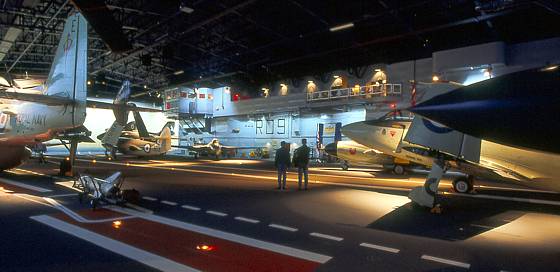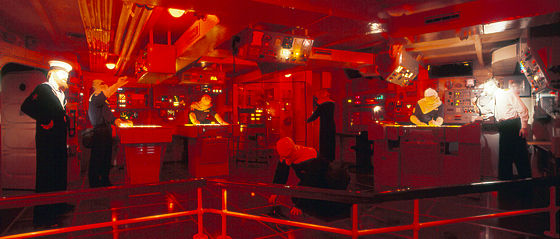![]()
The first part of the Carrier exhibition is a long corridor showing images and models of aircraft carriers from their beginnings up to the 1960s. But that is where all similarity to a conventional exhibition ends.
At the end of the corridor a voice announces the next flight to the aircraft carrier and a door opens revealing a Wessex helicopter. As the door on the helicopter closes behind you, the floor begins to shake and the pilot tells you are flying to out to the English Channel in 1975. The helicopter 'lands' and on disembarking you find yourself on the deck of an aircraft carrier.

The visitor is in a very large aircraft hangar (70 x 30 metres) dressed to look, sound, smell and feel like the flight deck of an aircraft carrier. Around three sides of the hangar is what must be one of the largest cycloramas ever made. It is a 130 metre long by 15 metre high painting of the dawn sky and sea.
Parked on the deck, which is painted in full detail and set with runway lights, are eleven aircraft of the Fleet Air Arm ranging from a Westland Wasp helicopter to a Macdonnell Douglas Phantom. On command from the Island (the superstructure of the aircraft carrier which fills the length of the fourth wall) the Phantom winds up its engines to full re-heat ready for take off. The sound is deafening.

The visitor can wander at will around these aircraft, but will eventually arrive at the entrance to the carrier interior and at the top of the stairs is met by the figure of Jack Tarr who will be their guide around the ship. They are shown through the Communications Room to the Bridge and then to the Operations Room, where a crisis has just arisen and doors are sealed as the fire crews are called to put out a small electrical fire.
'Ops' leads us on through a warren of rooms to a pilot briefing session where we are told that a Russian submarine is in trouble and the ship will have to alter course and launch aircraft to help it out. Eventually we emerge on the Goofers Deck, high up on the superstructure overlooking the deck. Here there are three interactive workstations which give the details and histories of the aircraft parked below.
On re-entering the ship and descending a flight of stairs the visitor is lead to the finale of the exhibition. Standing as if on a lift on the deck of a carrier, surrounded by a five channel, 1500W sound system, a nine metre wide, three screen video programme shows from a pilots eye view what it was like to land on the pitching deck. When the plane touches down the floor jolts and then the lift descends to take the visitor on to the next part of the museum.
Roy Reed produced all of the audio visual elements and many of the special effects, and was responsible for the technical design of the installation. He was a member of the project design team.